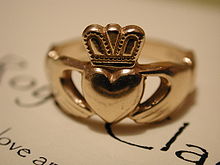There are many legends about the origins of the ring, particularly concerning Richard Joyce, a silversmith from Galway circa 1700, who is said to have invented the Claddagh design as we know it.[3][4] Legend has it that Joyce was captured and enslaved by Algerian Corsairs around 1675 while on a passage to the West Indies; he was sold into slavery to a Moorish goldsmith who taught him the craft.[11] King William III sent an ambassador to Algeria to demand the release of any and all British subjects who were enslaved in that country, which at the time would have included Richard Joyce. After fourteen years, Joyce was released and returned to Galway and brought along with him the ring he had fashioned while in captivity: what we've come to know as the Claddagh. He gave the ring to his sweetheart, married, and became a goldsmith with "considerable success".[15] His initials are in one of the earliest surviving Claddagh rings[6][16] but there are three other rings also made around that time, bearing the mark of goldsmith Thomas Meade.[6]
The Victorian antiquarian Sir William Jones described the Claddagh,[2] and gives Chambers' Book of Days[17] as the source, in his book Finger Ring Lore. Jones says:
In his 1911 book Rings for the Finger, American mineralogist George Frederick Kunz addresses the importance of gold wedding rings in Ireland but does not mention the Claddagh ring. He does, however, include a photo of one, captioned with its correct name.[1] Furthermore, it is unclear exactly how or when the ring was brought to the United States. In Rings Throughout the Ages (1945), James Remington McCarthy barely addresses the subject of Irish rings at all.[20]
An account written in 1906 by William Dillon, a Galway jeweller, claimed that the "Claddagh" ring was worn in the Aran Isles, Connemara and beyond.[18] Knowledge of the ring and its customs spread within the British Isles during the Victorian period, and this is when its name became established.[6] Galway jewellers began to market it beyond the local area in the 19th century.[6][19] Further recognition came in the 20th century.[9]
The Claddagh's distinctive design features two hands clasping a heart and usually surmounted by a crown. These elements symbolize the qualities of love (the heart), friendship (the hands), and loyalty (the crown). A "Fenian" Claddagh ring, without a crown, is a slightly different take on the design but has not achieved the level of popularity of the crowned version. Claddagh rings are relatively popular among the Irish[3] and those of Irish heritage, such as Irish Americans,[21] as cultural symbols and as friendship, engagement and wedding rings.[22]
While Claddagh rings are sometimes used as friendship rings, they are most commonly used as engagement and wedding rings. Mothers sometimes give these rings to daughters when they come of age. There are several mottos and wishes associated with the ring, such as: "Let love and friendship reign."[23] In Ireland, the United States, Canada, and other parts of the Irish diaspora, the Claddagh is sometimes handed down mother-to-eldest daughter or grandmother-to-granddaughter.[24]
According to Irish author Colin Murphy, a Claddagh ring was worn with the intention of conveying the wearer's relationship status:
- On the right hand with the point of the heart toward the fingertips: the wearer is single and may be looking for love.
- On the right hand with the point of the heart toward the wrist: the wearer is in a relationship.
- On the left hand with the point of the heart toward the fingertips: the wearer is engaged.
- On the left hand with the point of the heart toward the wrist: the wearer is married.[22]
There are other localised variations and oral traditions, involving the hand and the finger on which the Claddagh is worn. Folklore about the ring is relatively recent, not ancient, with "very little native Irish writing about the ring". Hence, the difficulty today in finding any source that describes or explains the traditional ways of wearing the ring.[25]



No comments:
Post a Comment